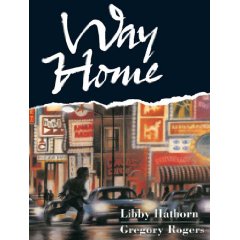 Chris Van Allsburg's books sometimes send very important messages, and other times are written simply to entertain. The book "Just a Dream" is one of his books that has a very strong message to it. In this book a young boy Walter has no cares for the world around him. He throws his trash on the ground, chooses not to sort the garbage, and hopes for a future filled with robots and machines that make life easy. That night when he goes to sleep he travels to the future. In this future his neighborhood has become a dumpster for massive amounts of trash. His bed then travels to a tree, but two men begin to cut the tree down to make toothpicks out of it. He also goes to the Grand Canyon and Mt Everst. The Grand Canyon is filled with smog from factories so it is difficult to see the enormous canyon, and a hotel has been placed on Mt Everst. He travels to other places in this future, but from what he sees he doesn't like the way things have turned out. After his dream Walter realizes that planes and robots aren't all that important, but what is important is the environment around him. He sorts the trash, and picks up his litter from the day before. And that night he has a dream about a very different future than the one from the previous night, and he seems to realize that the world around him is important.
Chris Van Allsburg's books sometimes send very important messages, and other times are written simply to entertain. The book "Just a Dream" is one of his books that has a very strong message to it. In this book a young boy Walter has no cares for the world around him. He throws his trash on the ground, chooses not to sort the garbage, and hopes for a future filled with robots and machines that make life easy. That night when he goes to sleep he travels to the future. In this future his neighborhood has become a dumpster for massive amounts of trash. His bed then travels to a tree, but two men begin to cut the tree down to make toothpicks out of it. He also goes to the Grand Canyon and Mt Everst. The Grand Canyon is filled with smog from factories so it is difficult to see the enormous canyon, and a hotel has been placed on Mt Everst. He travels to other places in this future, but from what he sees he doesn't like the way things have turned out. After his dream Walter realizes that planes and robots aren't all that important, but what is important is the environment around him. He sorts the trash, and picks up his litter from the day before. And that night he has a dream about a very different future than the one from the previous night, and he seems to realize that the world around him is important.This book sends a great message. It shows the importance of taking care of the environment. It also gives the reader a peek into a future where the people didn't care about their environment. And that future wasn't one that appealed to Walter, and probably not to the reader. This book shows us that we need to take care of the environment, and appreciate nature and its natural beauty. I that the culture we live in today doesn't value the world around us enough, and hopefully this book will help kids and adults reading it realize that we need to take care and enjoy the earth before it's too late.
I think this is a great book with a powerful message. It would be neat to incorporate this book into a science lesson where we are planting something or learning about the envrionment. I can also see reading it to my calss on Earth Day, and then having a discussion about it. This book will definitely be a part of my future classroom library.










